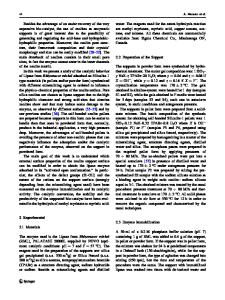A New Sulfonic Acid-Functionalized Organic Polymer Catalyst for the Synthesis of Biomass-Derived Alkyl Levulinates
- PDF / 1,125,483 Bytes
- 8 Pages / 595.276 x 790.866 pts Page_size
- 89 Downloads / 350 Views
A New Sulfonic Acid‑Functionalized Organic Polymer Catalyst for the Synthesis of Biomass‑Derived Alkyl Levulinates Yi Tian1 · Ruoqi Zhang1 · Wenguang Zhao1 · Sha Wen1 · Yanping Xiang1 · Xianxiang Liu1 Received: 22 February 2020 / Accepted: 2 May 2020 © Springer Science+Business Media, LLC, part of Springer Nature 2020
Abstract Alkyl levulinates are important biobased chemicals with great fuel-blending properties and good reactivity. In this work, a new functionalized nitrogen-containing organic polymer bearing sulfonic acid groups (PDVTA-SO3H) was successfully prepared and studied for the esterification of levulinic acid with alcohols to produce alkyl levulinates. The results showed that this sulfonic acid-functionalized organic polymer possessed high catalytic activity, and the yield of n-butyl levulinate reached 97.4% under the mild conditions. PDVTA-SO3H exhibited strong acidic sites and high stability, and would be well expected to be a potential candidate better than some commercial sulfonic solid catalysts for alkyl levulinates production. The catalyst had been reused without any treatment for five times and the results proved its potential for industrial applications. Graphic Abstract A new sulfonic acid-functionalized organic polymer showed high activity in the conversion of biomass derived levulinic acid into alkyl levulinates.
Keywords Biomass · Levulinic acid · Alkyl levulinates · Sulfonic acid · Organic polymer · Catalysis
1 Introduction Yi Tian and Ruoqi Zhang have contributed equally to this work. * Xianxiang Liu [email protected] 1
National & Local Joint Engineering Laboratory for New Petro‑Chemical Materials and Fine Utilization of Resources, Key Laboratory of the Assembly and Application of Organic Functional Molecules of Hunan Province, College of Chemistry and Chemical Engineering, Hunan Normal University, Changsha 410081, People’s Republic of China
In recent decades, the environmental pollution, climate warming, resource and energy crisis caused by the excessive consumption of fossil resources have increasingly become the focus of the academic and industrial circles around the world. The plenty amount of biomass resources, such as straws and fruit shells deriving from photosynthesis, can be seen as a huge treasure house of renewable resources [1]. Researchers have been devoting attention to practical transformation and utilization of cheap and renewable biomass
13
Vol.:(0123456789)
into fuels, fuel additives and chemicals in recent years [2–4]. Alkyl levulinates, a platform compound containing carbonyl and ester groups, can be widely applied in various fields like transportation, medicine, food, agricultural, cosmetics, fragrances, plastics and printing as a renewable resource [5]. For example, methyl levulinate (ML) and n-butyl levulinate (BL) both are basic raw materials in chemical production process [6, 7]; ethyl levulinate (EL) emerges as a promising fuel additive due to its short degradation time and low nitrogen-oxide emissions [8]. Alkyl levulinates can be obtained by
Data Loading...










